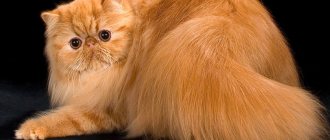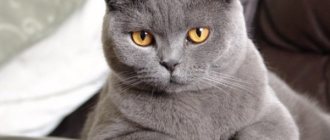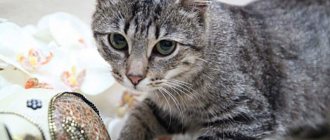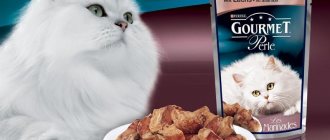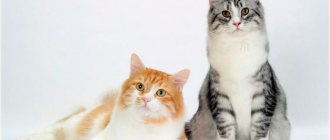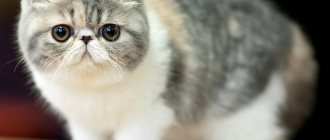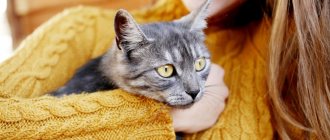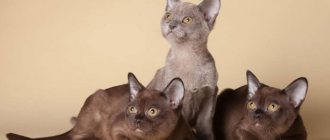Home » Cat Breeds
Sweet plush British cats, the only owners of “Cheshire” smiles among the entire cat tribe, resemble soft toys, and especially bear cubs. The standard of this breed allows a large number of colors (according to the latest data, more than sixty). Chocolate color is relatively new and still rare.
- 2 What is color and how new colors are developed
- 3 History of the breeding of British chocolate
- 4 Chocolate color standards for the British
4.1 Table: EMS encodings according to international standards WCF and FIFe
- 7.1 Video: British chocolate kitten
Who are the British
All representatives of the British breed, regardless of color, are distinguished by a rather massive and muscular physique. The body is compact, round and very harmoniously designed, with a wide, large chest and slightly short, strong legs. The average weight of males is 6–8 kg, but sometimes reaches 10 kg. Females are much smaller and lighter.
British cats have a massive build
The British have a large round head on a massive neck, with thick convex cheeks and a firm, pronounced chin. The ears are straight, medium-sized, and set wide apart. The eyes are large, round and well open. The tail is not distinguished by its outstanding size; at the base it is thickened to a rounded tip and slightly narrows. The coat is extremely thick and short with good quality undercoat and is very soft and pleasant to the touch.
Cat color - Chinchilla
The main background of the coat is white; black is found on the back, sides, head, tail and ears of the cat. There may be black fur on the face and legs, and the belly, chest, inner thighs and underside of the tail may be white or cream. Llamas have cat-like or black pads, and their eyes are bluish-green with black rims.
Variations allowed:
- Blue chinchilla: the main tone is blue, with a white undercoat, blue-gray paw pads and a reddish nose with a blue outline;
- Chocolate: the main tone is chocolate color, with a white undercoat, a reddish nose with a chocolate outline and dark paw pads (from coffee to chocolate color);
- Lilac: the main tone is lilac, with a white undercoat, a reddish nose with a pink outline and the same paw pads.
What is color and how are new colors developed?
The color of a cat refers to the color of the coat and the pattern on it. In general, domesticated cats are distinguished by an incredible variety of colors, unlike their wild relatives. There are not so many main genes responsible for the color of a mustachioed pet (solid color, lighteners, patterns, etc.), but their combination and various combinations create an endless number of options. Two genes are responsible for each trait, one of which is received from the mother, the other from the father. The task of a competent breeder is to correctly identify the necessary genes (dominant or recessive) and carefully select them to develop the desired shade.
Shaded colors of cats
This color got its name for a reason: the cat’s hairs are pigmented with the main color for about a third of the length of the coat. There is a gradual transition from dark to light shade, the undercoat can be cream or silver-white.
When the cat is calm, the transition of tones is practically unnoticeable, but when moving, the white-silver undercoat stands out. The color of the nose pads and nose should match the main color, the animal's eyes should be orange or copper.
Variations are allowed: blue, black, chocolate, golden tortoiseshell-chocolate, silver, lilac, tortoiseshell-lilac, cameo.
History of the breeding of British chocolate
Breeders were not involved in the targeted breeding of brown fur in British cats . This color is not so common; it is characteristic of eastern representatives of the cat family (Burmese, Oriental, Siamese, etc.). The goal of the breeding work was to obtain color-point color in plush cats, for which they were crossed with color-point Persians.
The purpose of breeding the breeders was the color point color, and the chocolate color turned out to be an accident
The first chocolate Briton was born by chance in the 80s of the last century. But the color was so deep and luxurious that later breeders began to strive for a pure dark brown shade. British cats of this color are very popular.
History of the breed
The state of Burma or in modern Myanmar in Southeast Asia is considered the place where the Burmese cat breed originated. According to legend, the ancestors of the Burmese cat lived in ancient temples and were revered as sacred animals. The distribution of the Burmese cat was supposed only within the kingdom.
Only in 1930, Mr. Joseph Cheeseman Thomson, an American doctor who visited this end of the earth, was able to get a kitten named Wong Mau. The Burmese received further development in San Francisco, where it was bred with a Siamese cat named Tai Mei. As a result of selection, kittens were born with the features of the Burmese mother and similar to the Siamese cat. The breed was not very attractive to cat lovers; they were considered Siamese mestizos. In 1936, the breed “Burmese cat” or translated as “Burmese cat” was officially registered in the USA according to the CFA standard. The American branch was formed from an exotic Burmese with a chocolate coat and a striking golden-amber eye color.
The Burmese appeared in Europe later, and selection work was also carried out there, but in a different direction. The public's first delight was in 1955 when a blue Burmese cat, nicknamed “Cat - the Blue Miracle,” received a blue color at an exhibition in London. From him came the European branch of the Burmese cat.
The American Burmese and European are different branches of Burmese cats, which are recognized as independent breeds with an individual description of the standard.
Burmese women of both branches have gained popularity all over the world, they have conquered distant Australia. In Russia, Burmese cats are not yet very common; their population is growing every year; both domestic nurseries have appeared, as well as in the countries of the former USSR.
Chocolate color standards for the British
There are very strict requirements for the chocolate color of British cats. According to the breed standard, the coat should be short and soft, but the structure should be elastic and not adhere to the animal’s body. A coat that is too soft and tight-fitting to the body or, conversely, a coat that is too harsh are considered serious faults. Due to the thick undercoat, the cat’s skin becomes plush, but excessive fluffiness is unacceptable.
The coat color should be a uniform deep and rich dark brown. Each hair is painted in one tone without play or flow along its entire length. The skin and undercoat are the same shade. The nose is only chocolate, but perhaps a little lighter than the main brown tone. The pads on the paws are also in dark chocolate tones. No stains, stripes, scorches or other effects are allowed by the standard. The animal must have an exceptionally even brown color, which is sometimes called chestnut, associating this color with the color of the ripe horse chestnut fruit. The saturation and density of the shade can vary from the color of a children's milk chocolate bar to a dark chocolate bar with a high cocoa content.
The coat of a Chocolate Briton should be colored evenly, without stripes, spots, marks, etc.
The color of expensive Havana cigars, which are also a rich dark brown, gave these Britons the nickname Havana.
The irises of the chocolate British are allowed only in yellow variations: from light copper to deep dark orange. Without the greenish rim often found in cats.
Chocolate Britons only have yellow eyes
Table: EMS encodings according to international standards WCF and FIFe
| Sign | Code | Name | |
| Breed | BRI | British shorthair | British Shorthair |
| Coat color | b | chocolate (brown, chestnut) | smooth brown or chestnut (chocolate) |
| Tail length | 54 | longy) | normal/long tail |
| Iris color | 62 | yellow, golden | yellow, golden, orange |
| Ears set | 71 | straight ears | straight - straight ears |
The darker and richer the chestnut color of the fur, as well as the brighter the eyes, the more valuable the cat is.
Tabby colored breeds
There are more than 20 cat breeds, among which there are tabby cats. For some breeds, this type of pattern is the only possible one.
Example of breeds with tabby capability:
- British;
- Siberian;
- Pixie bob;
- Bengal;
- Scottish;
- Ceylon;
- Persian;
- Safari;
- Toyger;
- Sokoke.
Sokoke cat
Some of the breeds have specific types of patterns. For example, British shorthairs are especially good in marbled tabby, Persian longhairs are distinguished by their frequent tortoiseshell coloration, toygers are interesting in mixing spots with stripes, and Abyssinian cats are most valuable in lilac colors (fawn). While color variations are possible in the breeds listed above, only all representatives of the breeds described below are presented in tabby coloring.
Abyssinian
Despite the name of the breed, there is still debate about its origin: African (Egypt) or Indian. The short-haired breed has a long-haired counterpart - the Somali cat is native to North America.
Abyssinian ticked cat
A significant area of their body appears to be a solid color, but the tail, paws and face may be marked with typical tabby patterns. The traditional “M” is often emblazoned on the forehead, and the eyes and nose are brightly outlined. The patterns clearly appear on the wool, but their color usually differs from the main one by only a few tones. Ticked color predominates. Common shades for Abyssinian and Somali cats: reddish-brown-black, reddish-yellowish, bluish-lilac.
Singaporean
All Singapura cats have the same color. The main color of the coat is from ivory to dirty gray with dark gray or brownish streaks.
Singapore tabby cat
The tabby color is predominantly ticked. Among the distinctive features of the breed pattern are:
- darkening on the back and front of the knees;
- shadows on the paws in the area of the feet;
- intermittent pattern on the forehead and muzzle.
On a note! The pattern on the body is more like ripples due to the frequent change of tones on the animal's hairs.
Egyptian Mau
The Egyptian Mau's coloration is formed naturally. Tabby type - leopard. Among the signs that allow us to classify a cat as a given breed, we will focus on the main ones:
- many spots of different sizes scattered throughout the body in a chaotic manner;
- various shapes of spots;
- contrastingly different color of the spots from the main shade of the coat;
- a clear “M” on the forehead, the pattern creates the impression of a frown on the cat;
- lines from the forehead go down, going down the back of the neck to the back, where they increase and break up into spots;
- characteristic lines on the cheeks;
- clear “necklaces” on the chest and neck of dotted lines;
- bracelets on the top of the front paws.
Egyptian Mau
The coat of the Egyptian Mau is characterized by the following colors: silver, bronze, haze, black, black haze.
Ocicat
The breed was bred artificially by crossing representatives of the spotted tabby breeds - the Abyssinian is one of the ancestors of the Ocicat. Outwardly, the Ocicat resembles a small leopard or Ocelot - an almost exact copy of a wild cat in a reduced size.
The color of Ocicat cats has several features:
- bright markings on the forehead, muzzle, paws and tail;
- a pattern in the form of chaotic spots on the body, paler than on the muzzle;
- Possible creamy, almost white markings on lips, cheeks, neck, chest and paws.
The Ocicat looks like a small leopard
The primary color (golden markings on an ivory background) was gradually diluted by others during selection: chocolate, bluish, lilac, violet, golden, silver with shades.
Mongrel cats
Often outbred pets also have a tabby pattern from birth, which indicates that they belong to the most beautiful color type. Moreover, such cats boast a variety of colors and patterns that cannot always be obtained through long-term purebred selection.
Anomalies and features inherent in the British chocolate color
The chocolate color is somewhat difficult to breed. Quite often, kittens are born in litters with residual stripes or spots, as well as with lightened undercoat. Which does not meet international standards, since the wool must be dyed evenly and uniformly. In addition, it is not immediately possible to understand exactly what shade of chocolate and what quality it will be.
At a certain period of time, the babies’ fur turns brown, acquiring an ugly yellowish-dirty hue. In most cases it goes away over time, but not always. Usually, only when the kitten reaches 12–15 months, and sometimes later (up to two years), does the complete development of color occur.
Chocolate British cat kittens do not immediately acquire their true color
Photos of Norwegian Forest cat kittens
Norwegian Forest Cat kittens.
Norwegian forest cat kitten.
Norwegian forest cat kitten.
See also: photo of the Norwegian Forest cat breed.
Special rules for caring for British dogs with chocolate skins
Caring for chestnut-colored animals is no different and consists of the following actions:
- Proper nutrition (varied and balanced). Both feeding options are acceptable: ready-made factory feeds of at least super premium class (preferably holistic);
- natural food
- against fleas - shampoos, drops, collars, etc.
Any violations in the maintenance of the animal and health problems immediately reduce the quality of the British coat. The wool loses its natural shine and becomes dull.
Smoky colors of cats
Such cats are colored smoky with possible variations - chocolate, lilac, tortoiseshell, blue or lilac-tortoiseshell, with a white-silver undercoat. White and silver tufts of wool are almost invisible, only when parsing the wool. Such cats are very contrasting: when they lie motionless, they appear monochromatic, but when walking, their silvery-white undercoat is clearly visible. The nose pads and nose should be colored to match the coat, and the eyes should be dark orange or copper.
Features of genetics and mating of British chocolate dogs
It is quite difficult to obtain a real, pronounced chocolate color from a cat's fur. In order for the offspring to have a dark brown coat, a necessary condition is the presence of a certain gene in both parents . In the gene set of a chocolate baby, it must be present in double size (from the mother and from the father). That is, both parents must have the same dark brown color.
The color of an animal's fur is determined by the presence of a coloring substance (pigment) in the hairs - melanin, which is present in the hair structure in the form of varying numbers of microscopic grains (granules) of different shapes and sizes.
Kittens are born chocolate only if both parents are the same color
There are two varieties of this pigment:
- eumelanin - gives black pigmentation;
- phaeomelanin - works in the yellow and red parts of the spectrum.
Strictly speaking, there is no specific gene responsible for chocolate. When the black pigment (B) is oxidized to red-yellow, a recessive oxidized gene is obtained that colors the coat brown (b). The kitten inherits one chromosome from both ancestors, so for the appearance of a chocolate baby, the combination bb must appear.
The intensity of the shade (dilution) depends on the D gene (Dilutor - diluent). In the dominant state of this gene, the granules of the coloring pigment in the hair are tightly packed, so the color will be thick and rich. If the form is recessive, then the color turns out faded and diluted. In British chestnuts this gene is dominant (D), so their color (like blacks) is hard and dense. The recessive position (d) gives a loose color (lilac or blue).
If one of the parents does not have chocolate coloring, but is a carrier of this gene, then only half of the kittens in the litter will turn out to be chocolate . Most often, a carrier female, who does not have the required brown tint, but has this gene in her gene set, is mated with a true 100% chocolate stud male. When crossing two carriers (very often a brother and sister), a maximum of only 25% of the offspring in the litter can be chocolate. There is also a certain risk in the fact that such kittens may not turn out at all.
One litter can have kittens of different colors
Thus, the basis of selection and the greatest value are not only the real chocolate Britons themselves, but also the carriers of this gene. Since the final color of the British with chestnut coat is formed very late, you have to wait a long time. Before this, young animals cannot be used for selection.
Chocolate Britons have retained the color point color in their gene set and are carriers of this gene, so they are often used for mating with cats of this color.
A good friend of mine has a gray British cat at home. She has no pedigree, as she was bought inexpensively from some distant relatives. A cat is bred every year with the same cat found through an advertisement. A stud cat of blue color and some very good blood. Few kittens are born, usually no more than 3–4. The colors vary; there are always blue and lilac kittens in the litter. But sometimes a chocolate baby is born, to the great joy of the owner. This suggests that both the cat and the cat have the chocolate gene, that is, they are its carriers.
Video: British chocolate kitten
Character and behavior
If animals could be divided according to zodiac signs, then the American Shorthair would be a typical Libra. They do not rush from one extreme to another, but maintain a balance in everything: in games, sleep, communication with the owner, friendship with other cats and dogs. They don’t mind playing, but you can’t call them restless, they are tolerant, but do not allow disrespect for their person, they love to communicate, but prefer not to intrude.
They are not talkative, but not silent either: if the “American” wants to talk or needs something, you will hear a quiet “meow” and feel how they delicately touch your leg with a paw. This cat definitely won’t start roulades in the back room; shouting is beneath her dignity.
“Americans” are affectionate: they patiently wait for their owners, sitting on the rug by the door, but they will not jump for joy and lick your hands. By the way, cats of this breed do not particularly like to sit on your hands, and, paying tribute to politeness, they directly make it clear that it is better to let them down.
The hunting instinct of the “Americans” is well developed. Even in an apartment, they will “give” a fight to both small midges and a butterfly that accidentally flies into the light of a lamp, and they know how to save household members from annoying mosquitoes better than any “Raptor”. If you live in a private house and from time to time you let your cat out into the yard for a walk, expect a gift in the form of a strangled sparrow or mouse. Do not scold your furry pet, but rather praise him: after all, he tried for you.
It is precisely because of the love of hunting that you should not bring rodents and birds together with your American Shorthair cat: neither cages nor constipation will save them. But “Americans” get along quite well with cats of other breeds and even dogs. Friendships rarely develop (“Americans” are quite independent people), but they definitely won’t fight for territory or attention.
They treat children condescendingly, as if I understand that one cannot expect prudence or accuracy from a little fool. “Americans” will not allow themselves to let out their claws or bite, but they will try to hide somewhere higher at the slightest attempt by your child to pull the cat’s tail.
These are smart and smart cats, but training is not their strong point. More precisely, not yours, and the “American” will show it to you with all his appearance. Of course, you can try, but only at an early age, come up with effective motivation and do not let the kitten get bored or very tired during exercise.
Peculiarities of chocolate British participation in cat shows
If a British chocolate cat exactly meets all breed standards, is healthy and has no external physical defects, and also has the necessary documents (pedigree), then it can take part in any cat shows.
Preparations for exhibition events are carried out in advance:
- The animal is bathed (if the coat looks oily) with a special shampoo. It is recommended to use conditioner (same brand).
- Clean ears and eyes.
- Carefully trim the claws.
- Using a special brush and toothpaste, brush your pet’s teeth (2-3 days before the event).
To prevent the rich brown color from fading or fading, the animal should not be exposed to direct sunlight. Tinting and tinting wool is strictly prohibited.
The show animal must meet all breed standards
Individuals with the following deficiencies are subject to disqualification:
- white inclusions, stripes, spots or lighter undercoat (brownish or gray);
- eyes of an inappropriate shade or rim around the iris;
- not brown color of the nose and paw pads;
- excess or insufficient number of fingers;
- undershot or overshot (more than 2 mm);
- tail defects (bends, creases);
- the coat is too long or very fluffy.
Our neighbor has a black cat who leads a free lifestyle. He spends most of the warm season outside, free-ranging. He comes home only to eat. Since in the summer he is often exposed to the sun, his fur fades greatly and becomes an unsightly brownish-brown color. In winter, when it is frosty outside, he sits at home and after molting again becomes blue-black.
Black color standards
According to all international standards, the black color code is n (sil, ebony, wild, sable). The outer coat, as well as the undercoat of the animal, must be evenly and evenly colored, each hair painted completely from the base to the very tip. No white or colored inclusions are allowed (spots, stripes, stains, etc.).
The coat of black cats should have a uniform color, without any spots or inclusions.
The nose, as well as the pads on the paws, are only black. Whiskers (vibrissae) are only acceptable if they are black. The eyes of cats with tar coats most often have all shades of yellow and green (from bright emerald green to olive or light sand).
The eyes of black cats are most often yellow-orange.
As they grow older, the color of the iris of pets' eyes becomes more faded, as if fading.
Our neighbor has several cats. They all prefer to lead a free life and are constantly on the street. One black cat has taken a fancy to our lawn and often basks on the grass in the sun. By autumn, its skin takes on a dirty brownish-reddish tint, since cats' fur also fades, just like people's hair. After the autumn molt, the pet again becomes coal black. Animals with dark coats that participate in exhibitions are recommended to be exposed to the open sun as little as possible. A balanced diet greatly influences the quality of the coat. In winter, the neighbor's cat, who loves to hunt mice and eats natural food, literally has shiny and glossy fur.
Black kittens are often born with blue eyes
Video: everything about black cats
Varieties of cat colors with white color
These colors are characterized by a combination of the main color with large white color spots. The spots must be clearly defined and demarcated. The presence of a white coating on the main background is not allowed. The nose and paw pads should be colored the same color as the coat.
Variations of any tortoiseshell and solid colors with white are allowed. Their varieties are determined by the number and shape of color spots.
For solid colors:
- White gloves (mitted) – white slippers may be present on the paws;
- Locket – a white spot on the cat’s chest;
- White buttons – several small specks of white;
- Two-color (bi-color) - color spots should be evenly distributed and have a similar shape and size, white color should not be dominant;
- Harlequin - on a white background there are several rounded spots that are interconnected;
- Van (van) - the name comes from Van cats, on a white background there are colored spots in the head and tail;
- Tuxedo (tuxedo) – the cat has white paws and chest, white on the head is allowed.
For tortoiseshell colors:
- Tortoiseshell and white – there are several white areas on the main tortoiseshell background;
- Blue-cream and white – there are several small white areas on a blue background;
- Calico - white spots on a tortoiseshell background, with white being the dominant color. Black and red markings should be well drawn;
- Dilute calico - the color is similar to the previous one, but the spots are blue and cream. Blue spots should be uniform, while cream spots may have markings;
- Patched tabby and white – a large amount of white is allowed, but the color spots must be large and clearly defined.
